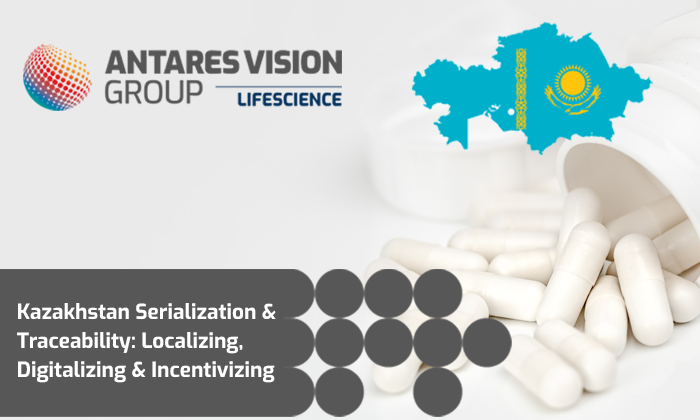We posted an Uzbekistan pharma serialization update the other day. This got us thinking about Kazakhstan serialization and traceability requirements, as Uzbekistan’s neighbor to the north is working to localize production, digitalize its infrastructure, and incentivize continued growth in key sectors, including pharmaceuticals.
So, welcome to the first of our two-part series about Kazakhstan serialization and traceability requirements. As we did in our series about the Africa supply chain, we’re going to start with context — information about the efforts mentioned above and a snapshot of what’s happening with the pharma industry. Part 2 will get into the specifics of Kazakhstan serialization and traceability requirements in pharma and other sectors.
Kazakhstan serialization and traceability requirements in context
To understand Kazakhstan serialization and traceability requirements, we must first understand what the country is doing to foster economic growth, including modernizing its infrastructure, developing its business enabling environment, and improving the lives of its citizens. Here’s a rundown of what’s been happening.
The Economy of Simple Things
Launched in March 2019, the Economy of Simple Things program is designed to increase domestic production of mostly low-tech, everyday consumer goods and services. The government also hopes to simultaneously boost demand for these goods, decrease reliance on imports, and increase “Made in Kazakhstan” exports.
The program was funded with 1 trillion tenge (almost $2.4 billion in 2019), of which 400 billion tenge (approximately $953 million) was earmarked for manufacturing and services. It was originally slated to end in July 2022 but was extended until the end of 2023.
When Prime Minister Alikhan Smailov announced the continuation, he said the Economy of Simple Things had subsidized more than 1,100 projects valued at almost $2.1 billion, had helped increase production output and payment of taxes by 33 percent and 80 percent, respectively, and had retained and created 67 jobs.
Digital Kazakhstan
Digital Kazakhstan aims to utilize digital technologies to “allow the economy, business, and citizens to enter a fundamentally new development trajectory.” It began in 2018; barring an extension, it will end this year.
The “new development trajectory” means Kazakhstan will work to transition to a digital economy that will improve people’s quality of life. The initiative focuses on five areas, each with publicly stated goals for “What will change/be changed by 2022”:
-
-
- Digitization of the economy: reorganization of the economy using technology to increase productivity and growth; focused on businesses of all sizes. Example of “what will change by 2022”: Labor productivity will increase to the level of “TOP-30 world countries.”
-
-
-
- Transition to the digital state: transformation of infrastructure to provide services for and anticipate the demands of people and business; calls for “open, transparent, and convenient opportunities” that can be accessed online 24/7. Example of “what will be changed by 2022”: Government services available in electronic format will increase by 80 percent.
-
-
-
- Implementation of the digital Silk Way: development of a high-speed, secure infrastructure for data transfer, storage, and processing (i.e., internet access and high-quality mobile communications coverage). Example of “what will change by 2022”: ICT development will reach the level of “TOP-30 countries.”
-
-
-
- Evolution of the human capital assets: transformational changes to enable a creative society and the “transition to the new realities”; calls for a knowledge-based economy and digital literacy through innovations in education. Example of “what will be changed by 2022”: Digital literacy will increase to 83 percent.
-
-
-
- Innovative ecosystem formation: foster a supportive environment for technological entrepreneurship and industry innovation characterized by stable relations between business, academic institutions, and government. Example of “what will be changed by 2022”: The Astana Hub will become an “international park of IT start-ups.”
-
Promoting pharma independence
According to the United Nations Comtrade database, a repository of official international trade statistics and relevant analytical tables, Kazakhstan’s pharma imports were valued at $1.56 billion in 2020.
The country’s efforts to attain pharma independence date to at least the mid-2010s. In 2014, for example, the now-discontinued State Program of Accelerated Industrial-Innovative Development (SPAIID) aimed to increase the share of domestically produced medicines to 40-50 percent of the overall market.
How far have they come toward that goal? In October 2020, The Asana Times reported that “the share of domestic manufacturers in the procurement of medicines and medical devices has grown to 30 percent and continues to grow steadily.” It also reported the following:
-
-
- In the first eight months of 2020, production volume increased 34.1 percent, reaching 81.5 billion tenge ($190.28 million).
- Investments into the industry reached 5.2 percent and 4.1 billion tenge ($9.57 million).
-
For a little more context, consider these stats from an analysis published in early 2021:
-
-
- In 2018, Kazakh pharma manufacturers produced products valued at 42 billion tenge (about $88 million at current exchange rates).
- In the first 9 months of 2019, the market for finished pharmaceutical products had grown to 460 billion tenge (about $966 million today), a 22-percent year-on-year increase.
-
To fuel growth, the government in September 2020 adopted the “Comprehensive Plan for the Development of the Pharmaceutical Industry” through 2025. As reported in the Asana Times, the plan includes the following benchmarks:
-
-
- Thirty new large pharmaceutical operations valued at 77.8 billion tenge ($163.4 million in 2020 dollars)
- Double medicine production to 230 billion tenge ($537.55 million)
- Triple exports to 75 billion tenge ($175.10 million)
- Train more than 2,000 specialists and create permanent jobs for them
- Increase domestic pharmaceutical production to 50 percent in physical terms
-
Furthermore, then-Prime Minister Askar Mamin directed the government to scale up support for the domestic pharma industry, especially by stimulating clinical and preclinical trials. He also tasked the Ministries of Industry and Infrastructure Development, Healthcare, and Foreign Affairs to incentivize blue-chip pharma companies to set up shop in Kazakhstan.
One last note for further context: Striving for pharma self-sufficiency isn’t a new idea. For example, earlier this year we wrote about Egypt’s Gypto Pharma City. The Egyptian government envisions this “medicine city” as a regional hub for the international pharmaceutical and vaccine industries, calling it “one of the most important national projects … with the aim of possessing the modern technological and industrial capacity in this vital field.”
Final thoughts
On August 8, the Kazakh Trade and Integration Ministry reported that the country boosted its exports to $34.2 billion between January and May 2022, a 37.2 percent increase over the same period last year.
It seems, then, that the Economy of Simple Things, Digital Kazakhstan, and the Comprehensive Plan for the Development of the Pharmaceutical Industry are reaping dividends. They’re promoting the economic vitality that will help propel the implementation of Kazakhstan serialization and traceability requirements across diverse industries, from pharmaceuticals to footwear.
We’ll talk about those requirements next week in in Part 2. In the meantime, take a look at our solutions for Kazakhstan and the other countries in the Eurasian Economic Union (EAEU). You can also contact us to schedule a short demo of our technologies — rfxcel and Antares Vision Group are committed to ensuring you’re compliant everywhere you do business.





